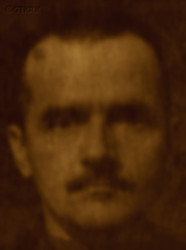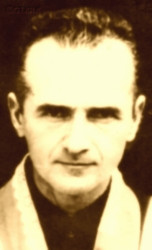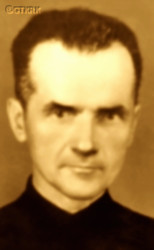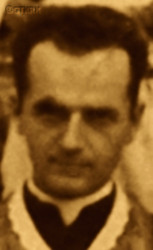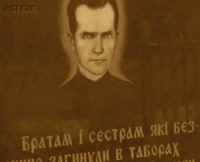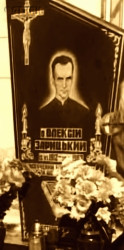Roman Catholic
St Sigismund parish
05-507 Słomczyn
85 Wiślana Str.
Konstancin deanery
Warsaw archdiocese, Poland
full list:
displayClick to display full list

searchClick to search full list by categories
wyświetlKliknij by wyświetlić pełną listę po polsku

szukajKliknij by przeszukać listę wg kategorii po polsku

Martyrology of the clergy — Poland
XX century (1914 – 1989)
personal data
religious status
blessed
surname
ZARYCKI
surname
versions/aliases
ŻARYCKI
forename(s)
Alexander (pl. Aleksander)
forename(s)
versions/aliases
Alex (pl. Aleksy)
beatification date
27.06.2001more on
www.swzygmunt.knc.pl
[access: 2013.05.19]

the RC Pope John Paul IImore on
en.wikipedia.org
[access: 2014.09.21]
function
eparchial priest
creed
Ukrainian Greek Catholic GCmore on
en.wikipedia.org
[access: 2013.05.19]
diocese / province
Lviv GC archeparchymore on
en.wikipedia.org
[access: 2013.05.19]
nationality
Ukrainian
date and place
of death
30.10.1963

ITL KarLagGuLAG slave labour camp network
today: Dolinka, Karaganda reg., Kazakhstan
more on
en.wikipedia.org
[access: 2019.10.13]
ru.wikipedia.org
[access: 2024.03.15]
details of death
Arrested by the Russians in 1946 — after the end of the military conflict of the World War II started by German and Russian invasion of Poland in 09.1939 and after start of another Russian occupation — for refusal to convert to Orthodoxy.
Jailed for 6 months in Złoczew.
On 10.10.1947 arrested again.
Jailed in Lviv, prob. in Łąckiego prison.
On 29.05.1948 tried by the court of Russian murderous MGB ministry (successor of genocidal NKVD) and sentenced to 10 years of slave labour in Russian concentration camps Gulag.
Transported to one of the concentration camps in Tayshet vicinity in Irkutsk Oblast (prob. ITL OzerLag).
Next transported to ITL DubravLag concentration camp; in Mordova republic.
Finally taken to Omlag concentration camp, n. Omsk in Siberia.
There on 31.12.1954 released, without a right to return home.
Stayed in exile in Karagandain Kazakhstan.
There on 09.05.1962 arrested again.
On 30.06.1962 sentenced to 2 years of slave labour.
Jailed in concentration camp in Dolinka village n. Karaganda (f. centre of ITL KarLag concentration camp).
Slaved as a tailor and perished in camp's „hospital”.
cause of death
extermination
perpetrators
Russians
sites and events
ITL KarLagClick to display the description, Forced exileClick to display the description, ITL OmLagClick to display the description, ITL DubravLagClick to display the description, ITL OzerLagClick to display the description, OsobLagsClick to display the description, GulagClick to display the description, Lviv (Łąckiego)Click to display the description, Ribbentrop‐MolotovClick to display the description, Pius XI's encyclicalsClick to display the description
date and place
of birth
17.10.1912

Bilchetoday: Mykolaiv urban hrom., Stryi rai., Lviv obl., Ukraine
more on
uk.wikipedia.org
[access: 2022.08.05]
parents
ZARYCKI Vasil
🞲 1886, ? — 🕆 1963, Bilchetoday: Mykolaiv urban hrom., Stryi rai., Lviv obl., Ukraine
more on
uk.wikipedia.org
[access: 2022.08.05]

ISYKOWA Mary
🞲 1895, ? — 🕆 1955, Bilchetoday: Mykolaiv urban hrom., Stryi rai., Lviv obl., Ukraine
more on
uk.wikipedia.org
[access: 2022.08.05]
presbyter (holy orders)
ordination
07.06.1936

Lvivtoday: Lviv urban hrom., Lviv rai., Lviv obl., Ukraine
more on
en.wikipedia.org
[access: 2022.01.16]
St George GC cathedral churchmore on
en.wikipedia.org
[access: 2018.09.02]
positions held
1957 – 1963
Greek Catholic Apostolic Administrator — Kazakhstan and Siberia — prob.; ministering in parishes all over Siberia, known as „Siberia Apostle”
1946 – 1947
parish priest — Riasne‐Rusketoday: Lviv urban hrom., Lviv rai., Lviv obl., Ukraine
more on
uk.wikipedia.org
[access: 2023.03.02] ⋄ St Demetrius the Martyr GC parish ⋄ Lvivtoday: Lviv urban hrom., Lviv rai., Lviv obl., Ukraine
more on
en.wikipedia.org
[access: 2022.01.16] GC deanery
1946 – 1947
curatus/rector/expositus — Ryasnetoday: part of Lviv, Lviv urban hrom., Lviv rai., Lviv obl., Ukraine
more on
uk.wikipedia.org
[access: 2023.03.02] ⋄ Nativity of the Blessed Virgin Mary GC chapel ⋄ Riasne‐Rusketoday: Lviv urban hrom., Lviv rai., Lviv obl., Ukraine
more on
uk.wikipedia.org
[access: 2023.03.02], St Demetrius the Martyr GC parish ⋄ Lvivtoday: Lviv urban hrom., Lviv rai., Lviv obl., Ukraine
more on
en.wikipedia.org
[access: 2022.01.16] GC deanery
1937 – 1946
administrator — Strutyntoday: Zolochiv urban hrom., Zolochiv rai., Lviv obl., Ukraine
more on
uk.wikipedia.org
[access: 2023.03.02] ⋄ Assumption of the Blessed Virgin Mary GC parish ⋄ Zolochivtoday: Zolochiv urban hrom., Zolochiv rai., Lviv obl., Ukraine
more on
en.wikipedia.org
[access: 2021.12.19] GC deanery
1936 – 1937
administrator — Verkhnya Stynavatoday: Hrabovets‐Duliby hrom., Stryi rai., Lviv obl., Ukraine
more on
uk.wikipedia.org
[access: 2023.03.02] ⋄ St Nicholas the Wonderworker GC parish ⋄ Lyubyntsitoday: Hrabovets‐Duliby hrom., Stryi rai., Lviv obl., Ukraine
more on
uk.wikipedia.org
[access: 2023.03.02] GC deanery
1936 – 1937
administrator — Nyzhnya Stynavatoday: Hrabovets‐Duliby hrom., Stryi rai., Lviv obl., Ukraine
more on
uk.wikipedia.org
[access: 2023.03.02] ⋄ St Michael the Archangel GC parish ⋄ Lyubyntsitoday: Hrabovets‐Duliby hrom., Stryi rai., Lviv obl., Ukraine
more on
uk.wikipedia.org
[access: 2023.03.02] GC deanery
1931 – c. 1934
student — Lvivtoday: Lviv urban hrom., Lviv rai., Lviv obl., Ukraine
more on
en.wikipedia.org
[access: 2022.01.16] ⋄ philosophy and theology, Greek Catholic Theological Academy
1931 – c. 1936
student — Lvivtoday: Lviv urban hrom., Lviv rai., Lviv obl., Ukraine
more on
en.wikipedia.org
[access: 2022.01.16] ⋄ philosophy and theology, Greek Catholic Theological Seminary
others related
in death
ŻOŁNIEROWICZClick to display biography Ignatius, DIDŽIOKASClick to display biography Vladislav, CHAMCZUKClick to display biography Gregory, DOBRIAŃSKIClick to display biography Nicholas, SKLEPOWICZClick to display biography Basil, CZECHUTClick to display biography Paul, WASYLKIEWICZClick to display biography Mokiy, WERBOWIECKIClick to display biography Basil, BUDKAClick to display biography Nicetas
sites and events
descriptions
ITL KarLag: Russian Rus. Исправи́тельно‐Трудово́й Ла́герь (Eng. Corrective Labor Camp) ITL Rus. Карагандинский (Eng. Karagandskiy) — concentration and slave forced labor camp (within the Gulag complex) — with headquarters in the city of Karaganda, Karaganda Oblast in Kazakhstan. Founded on 17.09.1931. One of the largest in the Gulag complex. It covered an area of 300 by 200 km, with its center in the Dolynka village, c. 45 km from Karaganda. One of the tasks was to grow food, especially animal husbandry, for the emerging centers of coal mining and heavy industry in Kazakhstan. Prisoners slaved in camp workshops (metal processing, drawing, tailoring), in the production of construction materials, in a glassworks, a sugar refinery, a vegetable drying plant, in coal mines, limestone mining, and in fishing. At its peak, c. 65,000 prisoners were held there: e.g. 45,798 (01.01.1943); 50,080 (01.01.1944); 53,946 (01.01.1945); 60,745 (01.01.1947); 63,555 (01.01.1948); 65,673 (01.01.1949); 54,179 (01.01.1950); 45,675 (01.01.1951). In total, c. 1,000,000 people passed through the camp, including many women and children. Many died. It ceased operations on 27.07.1959. (more on: en.wikipedia.orgClick to attempt to display webpage
[access: 2019.10.13])
Forced exile: One of the standard Russian forms of repression. The prisoners were usually taken to a small village in the middle of nowhere — somewhere in Siberia, in far north or far east — dropped out of the train carriage or a cart, left out without means of subsistence or place to live. (more on: en.wikipedia.orgClick to attempt to display webpage
[access: 2014.12.20])
ITL OmLag: Russian Rus. Исправи́тельно‐Трудово́й Ла́герь (Eng. Corrective Labor Camp) ITL Rus. Омскстроя (Eng. Omstroya) — concentration and slave forced labor camp (within the Gulag complex) — with headquarters in the city of Omsk, in the Omsk Oblast. Founded on 20.05.1950. Prisoners, many of whom were Poles, worked as slaves in the construction of an oil refinery and a thermal power plant, an airport, military warehouses, a rail bridge over the Om River and many other infrastructural projects (such as power lines, residential, social and cultural buildings, brick factory, reinforced concrete and reinforced concrete products, car depot, city sewage system and sewage treatment plant, roads, cinder block factory, etc.), as well as at quarries in the village of Borove in the Kokshetau region (today in Kazakhstan). At its peak — till the death on 05.03.1953 of Russian socialist leader, Joseph Stalin — c. 30,000 prisoners were held there: e.g. 21,335 (01.01.1953); 28,646 (01.04.1953). Ceased to exist on 24.07.1953 — renamed to Omskiy ITL (Omskiy Lag). (more on: old.memo.ruClick to attempt to display webpage
[access: 2022.08.17], old.memo.ruClick to attempt to display webpage
[access: 2022.08.17])
ITL DubravLag: Russian Rus. Исправи́тельно‐Трудово́й Ла́герь (Eng. Corrective Labor Camp) ITL Rus. Дубравный (Eng. Dubravniy) — concentration and slave forced labor camp (within the Gulag complex) — headquartered in Yavas in Republic of Mordovia. Founded on 28.02.1948, in place of ITL TemLag camp, and until 1954 also functioning as the Rus. Особый лагерь (Eng. Special camp) GULAG No. 3. Prisoners slaved at operating the Temnykovskiy industrial complex built by ITL TemLag prisoners: sewing factories, woodworking plants (e.g. furniture production), factories producing building materials (bricks, tiles, lime, building stone), railway lines, energy plants, peat extraction, wood chemical plants, etc. At its peak — till the death on 05.03.1953 of Russian socialist leader, Joseph Stalin — c. 26,000 prisoners were held there: e.g. 23,273 (01.01.1949); 23,532 (01.01.1950); 23,541 (01.01.1951); 25,616 (01.01.1952); 20,680 (01.01.1953); 16,980 (01.01.1954). Formally closed its operations in 1960, but political prisoners were held there for many years later — among them Ukrainian priests and Russian dissidents — until its final closure in the second half of the 1980s. (more on: old.memo.ruClick to attempt to display webpage
[access: 2024.04.08], archive.khpg.orgClick to attempt to display webpage
[access: 2014.09.21])
ITL OzerLag: Russian Rus. Исправи́тельно‐Трудово́й Ла́герь (Eng. Corrective Labor Camp) ITL Rus. Озерный (Eng. Ozerniy) — concentration and slave forced labor camp (within the Gulag complex) — headquartered in the town of Taishet in the Irkutsk Oblast (in 1953‐1954 temporarily in Bratsk, in the same oblast). Founded on 07.12.1948 and until 1954 also functioning as the Rus. Особый лагерь (Eng. Special camp) GULAG No. 7. Prisoners among whom were many Poles slaved at the construction of the Baikal‐Amur railway — initially the Tayshet‐Bratsk section, and then from Bratsk to Ust'‐Kut (distance c. 700 km), at forest clearing and wood processing, and the related maintenance of industrial complexes, and the construction of a hydroelectric power plant , in quarries, in lime production, in agriculture and in the production of consumer goods, etc. At its peak — till the death on 05.03.1953 of Russian socialist leader, Joseph Stalin — c. 37,000 prisoners were held there: e.g. 31,881 (01.01.1950); 33,325 (01.01.1951); 37,093 (01.01.1952), one quarter of them were women; 31,225 (01.01.1953); 36,152 (01.02.1953); 29,347 (01.01.1954). Ceased to exist in 1960. (more on: old.memo.ruClick to attempt to display webpage
[access: 2024.04.08], gulagmuseum.orgClick to attempt to display webpage
[access: 2014.11.14])
OsobLags: Pursuant to Decree No. 416‐159сс dated 21.02.1948 of the Russian government, the Russian criminal organization MVD (successor to the NKVD) issued a Decree No. 00219 of 28.02.1948 establishing a separate network of camps within the Gulag system for a „special group” of political prisoners sentenced under Art. 58 of the Penal Code (referring to „enemies of the people”, i.e. accused of treason, espionage, terrorism, etc.) Initially, the group of camps included the ITL MinLag, ITL GorLag, ITL DubravLag, ITL StepLag and ITL BerLag concentration camps. Later, the following ones were added: ITL RechLag, ITL OzerLag, ITL PeschanŁag, ITL LugLag, ITL Kamyshlag, ITL DalLag, ITL VodorazDelLag. After the death of the Russian socialist leader, Joseph Stalin, in 1953, the three largest revolts in the history of the Gulag took place there: the Norilsk Uprising, the Vorkuta Uprising and the Kengir Uprising. In c. 1954 the camps were converted into standard correctional camps. (more on: en.wikipedia.orgClick to attempt to display webpage
[access: 2024.01.26])
Gulag: The acronym Gulag comes from the Rus. Главное управление исправительно‐трудовых лагерей и колоний (Eng. Main Board of Correctional Labor Camps). The network of Russian concentration camps for slave labor was formally established by the decision of the highest Russian authorities on 27.06.1929. Control was taken over by the OGPU, the predecessor of the genocidal NKVD (from 1934) and the MGB (from 1946). Individual gulags (camps) were often established in remote, sparsely populated areas, where industrial or transport facilities important for the Russian state were built. They were modeled on the first „great construction of communism”, the White Sea‐Baltic Canal (1931‐1932), and Naftali Frenkel, of Jewish origin, is considered the creator of the system of using forced slave labor within the Gulag. He went down in history as the author of the principle „We have to squeeze everything out of the prisoner in the first three months — then nothing is there for us”. He was to be the creator, according to Alexander Solzhenitsyn, of the so‐called „Boiler system”, i.e. the dependence of food rations on working out a certain percentage of the norm. The term ZEK — prisoner — i.e. Rus. заключенный‐каналоармец (Eng. canal soldier) — was coined in the ITL BelBaltLag managed by him, and was adopted to mean a prisoner in Russian slave labor camps. Up to 12 mln prisoners were held in Gulag camps at one time, i.e. c. 5% of Russia's population. In his book „The Gulag Archipelago”, Solzhenitsyn estimated that c. 60 mln people were killed in the Gulag until 1956. Formally dissolved on 20.01.1960. (more on: en.wikipedia.orgClick to attempt to display webpage
[access: 2024.04.08])
Lviv (Łąckiego): Prison at Łącki Str. in Lviv. Founded in 1918‐1920 by Polish authorities, mainly for political prisoners. From 1935 used as investigative jail. After German and Russian invasion of Poland in 09.1939 and start of the World War II, after start of Russian occupation Russians — local branch of Russian genocidal NKVD organisation — held thousands of prisoners, mainly Poles and Ukrainians, in prison (then prison no 1). It was also a place of carrying out death sentences passed by Russian summary courts on Poles suspected of participation in Polish clandestine resistance activities. In 06.1941, after German attack on 22.06.1941 of their erstwhile ally, Russians, NKVD agents slaugher — during genocidal massacres of prisoners — c. 924 inmates. During German occupation that followed in 1941‐1944 the prison’s buildings held German Gestapo investigative jail. It was a place of executions. In 1944‐1991, after German defeat and start of another Russian occupation, the building were again used by NKVD (and it successor MVD) as investigative jail and also investigative department. (more on: pl.wikipedia.orgClick to attempt to display webpage
[access: 2014.10.31])
Ribbentrop‐Molotov: Genocidal Russian‐German alliance pact between Russian leader Joseph Stalin and German leader Adolf Hitler signed on 23.08.1939 in Moscow by respective foreign ministers, Mr. Vyacheslav Molotov for Russia and Joachim von Ribbentrop for Germany. The pact sanctioned and was the direct cause of joint Russian and German invasion of Poland and the outbreak of the World War II in 09.1939. In a political sense, the pact was an attempt to restore the status quo ante before 1914, with one exception, namely the „commercial” exchange of the so‐called „Kingdom of Poland”, which in 1914 was part of the Russian Empire, fore Eastern Galicia (today's western Ukraine), in 1914 belonging to the Austro‐Hungarian Empire. Galicia, including Lviv, was to be taken over by the Russians, the „Kingdom of Poland” — under the name of the General Governorate — Germany. The resultant „war was one of the greatest calamities and dramas of humanity in history, for two atheistic and anti‐Christian ideologies — national and international socialism — rejected God and His fifth Decalogue commandment: Thou shall not kill!” (Abp Stanislav Gądecki, 01.09.2019). The decisions taken — backed up by the betrayal of the formal allies of Poland, France and Germany, which on 12.09.1939, at a joint conference in Abbeville, decided not to provide aid to attacked Poland and not to take military action against Germany (a clear breach of treaty obligations with Poland) — were on 28.09.1939 slightly altered and made more precise when a treaty on „German‐Russian boundaries and friendship” was agreed by the same murderous signatories. One of its findings was establishment of spheres of influence in Central and Eastern Europe and in consequence IV partition of Poland. In one of its secret annexes agreed, that: „the Signatories will not tolerate on its respective territories any Polish propaganda that affects the territory of the other Side. On their respective territories they will suppress all such propaganda and inform each other of the measures taken to accomplish it”. The agreements resulted in a series of meeting between two genocidal organization representing both sides — German Gestapo and Russian NKVD when coordination of efforts to exterminate Polish intelligentsia and Polish leading classes (in Germany called «Intelligenzaktion», in Russia took the form of Katyń massacres) where discussed. Resulted in deaths of hundreds of thousands of Polish intelligentsia, including thousands of priests presented here, and tens of millions of ordinary people,. The results of this Russian‐German pact lasted till 1989 and are still in evidence even today. (more on: en.wikipedia.orgClick to attempt to display webpage
[access: 2015.09.30])
Pius XI's encyclicals: Facing the creation of two totalitarian systems in Europe, which seemed to compete with each other, though there were more similarities than contradictions between them, Pope Pius XI issued in 03.1937 (within 5 days) two encyclicals. In the „Mit brennender Sorge” (Eng. „With Burning Concern”) published on 14.03.1938, condemned the national socialism prevailing in Germany. The Pope wrote: „Whoever, following the old Germanic‐pre‐Christian beliefs, puts various impersonal fate in the place of a personal God, denies the wisdom of God and Providence […], whoever exalts earthly values: race or nation, or state, or state system, representatives of state power or other fundamental values of human society, […] and makes them the highest standard of all values, including religious ones, and idolizes them, this one […] is far from true faith in God and from a worldview corresponding to such faith”. On 19.03.1937, published „Divini Redemptoris” (Eng. „Divine Redeemer”), in which criticized Russian communism, dialectical materialism and the class struggle theory. The Pope wrote: „Communism deprives man of freedom, and therefore the spiritual basis of all life norms. It deprives the human person of all his dignity and any moral support with which he could resist the onslaught of blind passions […] This is the new gospel that Bolshevik and godless communism preaches as a message of salvation and redemption of humanity”… Pius XI demanded that the established human law be subjected to the natural law of God , recommended the implementation of the ideal of a Christian state and society, and called on Catholics to resist. Two years later, National Socialist Germany and Communist Russia came together and started World War II. (more on: www.vatican.vaClick to attempt to display webpage
[access: 2023.05.28], www.vatican.vaClick to attempt to display webpage
[access: 2023.05.28])
sources
personal:
pl.wikipedia.orgClick to attempt to display webpage
[access: 2013.05.19]
original images:
www.youtube.comClick to attempt to display webpage
[access: 2021.12.19], bilche.at.uaClick to attempt to display webpage
[access: 2014.12.20], preobrazhennja.org.uaClick to attempt to display webpage
[access: 2016.03.14], www.saintjosaphat.orgClick to attempt to display webpage
[access: 2016.03.14], www.gloria.tvClick to attempt to display webpage
[access: 2014.12.20], www.youtube.comClick to attempt to display webpage
[access: 2021.12.19]
LETTER to CUSTODIAN/ADMINISTRATOR
If you have an Email client on your communicator/computer — such as Mozilla Thunderbird, Windows Mail or Microsoft Outlook, described at WikipediaPatrz:
en.wikipedia.org, among others — try the link below, please:
LETTER to CUSTODIAN/ADMINISTRATORClick and try to call your own Email client
If however you do not run such a client or the above link is not active please send an email to the Custodian/Administrator using your account — in your customary email/correspondence engine — at the following address:

giving the following as the subject:
MARTYROLOGY: ZARYCKI Alexander
To return to the biography press below:
 Click to return to biography
Click to return to biography








